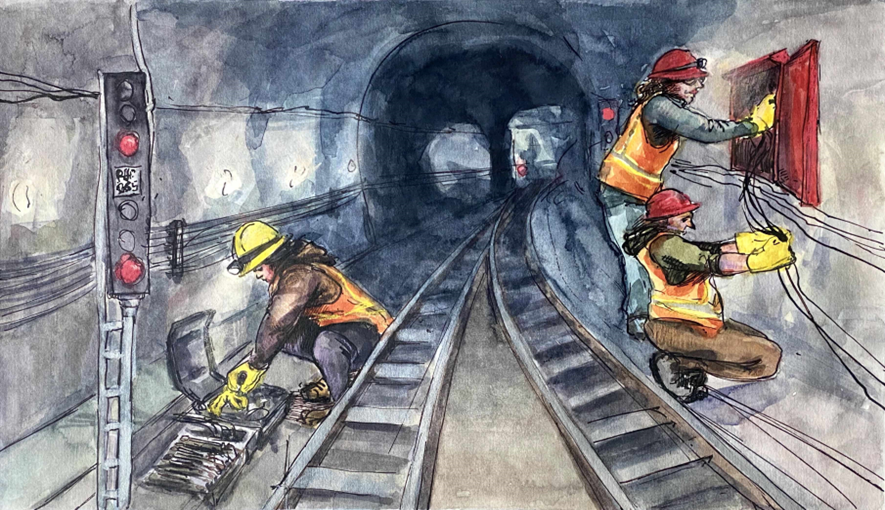A Review of a New Small Book That Tells Young Women They Can be Electricians Too
Harry Targ
People work for a lot of reasons; reasons that are not
necessarily in conflict. First, people work to earn a living. Only the super-rich,
the ruling class, do not have to work as most people experience it. Second,
people work to produce goods and services that serve their communities; from
the food we eat, to the buildings we live in, to the education our children
receive, to the medical care that keeps us healthy and alive. Third, people
work because it fills time and hopefully, gives dignity and hope. People
identify with their jobs and to a degree their self-concepts are shaped by
their jobs.
However, for many work does not provide sufficient
resources to live healthy lives. Workers often are forced to produce objects
that do not serve communities but facilitate destroying them, such as
manufacturing arms, or pursuing certain kinds of police work or surveillance.
And for many workers, boring, routine, assembly line jobs do not give dignity
and hope. They dehumanize people. And finally, work is foisted upon people
against their will in a system of economic exploitation that for many
constitutes modern slavery. And to do this capitalists, managers, and bosses
exploit workers often reinforcing old cultural ideas about who can do what kind
of work.
But with the rise of the feminist movement,
progressive trade unions, and demands in society for cultural change, workers,
particularly women workers are finding work that earns livable wages, channels
their energies and talents to the community, and provides them self-satisfying
and dignified labor.
WireWomen:
What It’s Like to be a Female Union Electrician (Hardball and Little
Heroes Press, 2022) is a beautiful book, text and wonderful graphics, that
describes and celebrates women electricians. It is written by seven women and one-man
all apprentice electricians, and one journey woman and a professor of labor
economics, It is illustrated by a “multi-disciplinary artist” interested in the
intersections between art and social movements, The apprentices are members of
the International Brotherhood of Electrical Workers (IBEW) Local 3 in New York.
These IBEW apprentices take a five-year electricians course which includes
training in the classroom and on-the-job. In addition, apprentices take college
courses leading to an associate or bachelor’s degree in Labor Studies at Empire
State College, SUNY.
The text describes the success these apprentices have
achieved in their “search for daily meaning,” helping to build skyscrapers,
installing revolving doors, adding electrical wires to tall buildings, wiring
subway systems, wiring guidance systems for Air Traffic Controllers at
airports, and even stringing the lights for the Christmas tree in Rockefeller
Center. And all of these tasks are beautifully presented in colorful, exciting
illustrations adjacent to the text which highlight the vital role electricians
play in society.
And WireWomen reminds readers, mostly girls and young women (but males as well) that the possibilities of careers as electricians are available to everyone. The book demands that young people forget the old stereotypes of who could do what work. It encourages young women particularly to pursue their evolving interests and dreams. If they are curious about electricity, have a fascination for using tools, want to know “how things work,” the book suggests, they can enroll in a union apprentice program, learn a skill, and secure lucrative employment doing self-actualizing work. “We like to make our work look good because we take pride in what we do and are committed to doing a good job….We use our brains, eyes, ears, and touch to make sure everything is just right.” As Studs Terkel once wrote:
WireWomen come
from all income levels, ethnicities, and races, and from different kinds of
prior job experiences. And what brings them together is their passion and
curiosity and a union that is committed to the dignity of work and workers. The
union provides “the best training, excellent health care and pensions, safe
working conditions, and good pay.” In New York state the average wage of
electricians is $81,340. In the United States union women in all jobs earn a
lot more than women in non-union jobs (about $195 per week more).
WireWomen also is an example of a potentially powerful new genre of literature that combines text and illustration in an engaging way. In ways analogous to graphic novels and documentaries, the reader is drawn into the text by the attractiveness and power of the visual images that accompany it. And in the case of WireWomen the authors want to attract and engage the readers with a message, challenging traditional stereotypes of what women can do. Also, the authors wish to recognize that progressive trade unions can facilitate growing opportunities of women in the workplace.
Educational institutions and union locals should order
multiple copies of WireWomen to hand out to young women (and men) who
evidence some curiosity about becoming an electrician. It could be an
excellent recruiting tool.
(Hardball and Little Heroes Press publishes fiction and non-fiction books for adults and children that take a working-class perspective. The Lennie Moss series written by Tim Sheard and numerous other fictional books about workers and unions entertain and enlighten. The Little Heroes series provides education and entertainment for younger readers.) https://www.hardballpress.com/index.html







